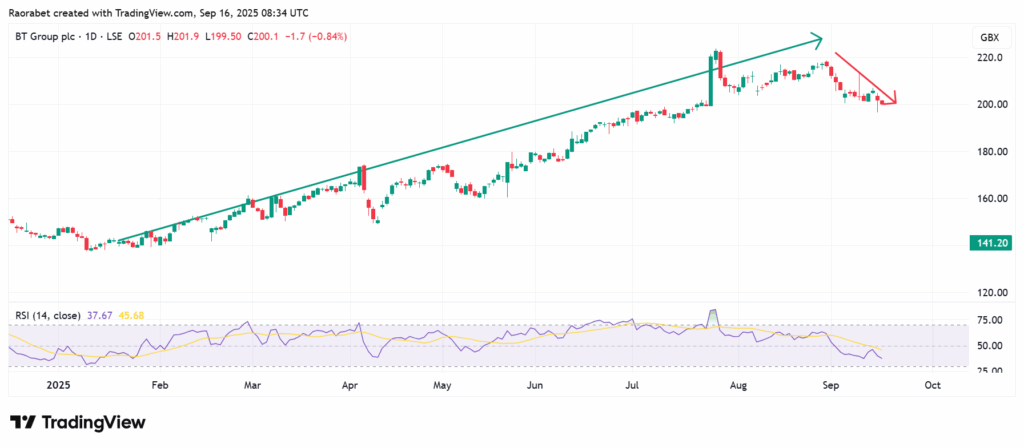- BT stock price has risen by about 40% since the year began but hit a barrier in late August. We discuss this and assess recovery pathway.
BT Group plc (LSE: BT.A) has been one of the best-performing stocks at the LSE for most of the period 2025. As of this writing, BT stock price has risen by about 40% this year and given patient investors a total return of more than 45%, including dividends. However, since late August, the telecom giant’s stock has been on a general downtrend.
It went from a high of about 217p on August 27 to about 200p by mid-September, a drop of about 8%. This poor performance goes against the trend of the rest of the market, and as a result, some shareholders are worried. Even though the FTSE 100 has been rising slowly, BT’s rapid rise practically guaranteed a pullback.

A daily chart showing BT Stock Price uptrend in 2025 with a notable decline since late August. Source: TradingView
Why Has BT Stock Been Underperforming?
BT’s current challenges are due to a combination of operational problems and investor concerns that were exacerbated by high-profile business moves. In late August, the shares were close to a five-year high, thanks to past cost-cutting efforts and strong demand for Openreach’s fiber-to-the-premises (FTTP) connections. In the first half of fiscal 2025, net additions for these connections were up 46% year over year.
BT’s half-year results in late July were a big reason for the change. In the end, the company met some expectations for cost discipline but showed that revenue was still weak. Adjusted revenues fell 3% to £4.87 billion because of lower sales of handsets and tough international markets. As a result of increasing net financing costs and depreciation from continuing network improvements, pre-tax profits dropped 10% to £468 million.
Is There a Way Back Up?
Even though things have been tough for BT stock lately, there is a clear plan for improvement and maybe even growing in the long term. The company is working on a number of strategic actions that could improve performance in the future and boost investor confidence. These include:
- Investment in Infrastructure: BT is the UK’s biggest investor in digital infrastructure, putting billions into building its full-fibre and 5G networks. The company’s full-fiber network had already crossed over 19 million homes and businesses by mid-2025. It is really important that this buildout goes well. As more homes and companies get connected to the new high-speed network, it will bring in steady income. Ultimately, that will likely secure BT the top telecom company in the UK.
- Cost cutting: By the end of fiscal 2025, the business plans to cut its annual expenses by £3 billion, with £1 billion already saved. This will free up money for high-return investments like Openreach’s FTTP network.
- Strategic Partnerships and Divestments: BT is actively streamlining its portfolio and adopting new technologies, as seen in its recent actions to sell its Radianz company and partnership with CoreWeave to look into AI integration. These steps can create value and show that the management team is looking ahead.
- Shareholder Confidence: The recent nomination of two board members from Bharti Global, a major investor, and a recent court victory that threw out a major lawsuit could help ease any remaining fears about legal and governance issues. These changes could make shareholders more confident and give BT stock a more steady footing.
What are the risks?
A recovery by BT stock price is possible, but investors should be mindful of the big risks that might impede the company’s traction and keep its stock price down.
- Rising competition: The biggest concern is that competition is becoming more intense. Rival companies like Vodafone and Three’s merger is coming up, which would hurt BT’s market share in mobile phones. At the same time, alt-nets like CityFibre are trying to break Openreach’s monopoly.
- High Debt and Capex: BT has a lot of debt on its balance sheet. In addition, its big infrastructure projects need a lot of capital expenditure (capex). If the economy contracts or the company has to incur costs it didn’t foresee, it could put a burden on its finances and make it harder for it to reach its targets.
- Regulatory Scrutiny: Because BT is a major player, regulatory authorities like Ofcom are always watching it. Ofcom’s close focus on pricing and sharing infrastructure adds to the uncertainties and could limit FTTP profits to 40%.
- Dividend Volatility: The company has paid dividends in the past, but its record has been inconsistent. Investors who have kept BT stock for the income it has historically provided may be disappointed to hear that future dividend payments may be at risk due to increased capex pressure.
In Conclusion
Considering all of this, BT stock’s poor performance since late August seems to be caused more by a combination of profit-taking, earnings disappointments, competitive pressures, and concerns about financial risk, especially debt burden. However, there is a viable way back up. If BT can demonstrate that it can handle regulatory pressures, deliver substantial fiber growth, better cash flow, and lower costs, the market could reward that by buying more of the company’s stock.
The decline has primarily been due to revenue softness, Bharti board appointments sparking governance fears, and profit-taking after a rally.
Yes, BT stock price could recover if it successfully implements cost-cutting, fiber expansion, 5G upgrades, and Bharti partnerships, all of which could significantly increase earnings and improve margins.
The most significant risk facing BT the escalating competition from rivals like Virgin Media O2 and CityFibre, which could impact the company’s market share and limit profitability.
This article was originally published on InvestingCube.com. Republishing without permission is prohibited.


